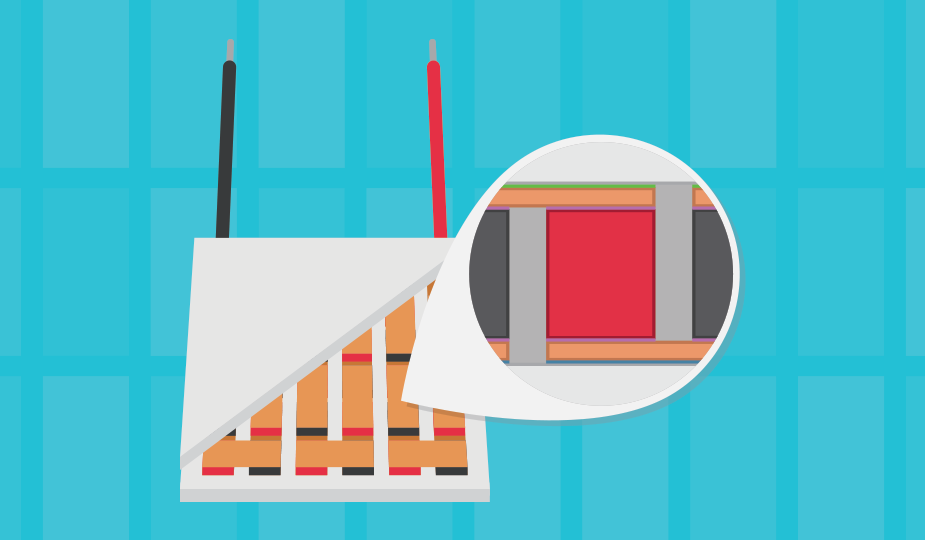arcTEC™ Structure – Improved Performance and Longer Life in Peltier Modules

Peltier devices are becoming ever more popular due to their reliable solid-state construction, their ability to actively cool to sub-ambient temperatures, and their ability to enable precise temperature control. While all Peltier devices share the same basic construction and operate using the same principles, discovered by Thomas Seebeck and Jean Peltier, differences in structure can have a significant impact on their performance.
Interested in more Peltier modules content? Check out our other blog topics:
- How to Select a Peltier Module
- Reliability Considerations for Peltier Modules
- How to Design a Peltier Module System
- Or watch our How to Select a Peltier Module video
General Peltier Structure
A typical thermoelectric module consists of an array of Bismuth Telluride semiconductor pellets that have been “doped” so that one type of charge carrier – either positive or negative – carries the majority of the current. The pairs of P/N pellets are configured so that they are connected electrically in series, but thermally in parallel. Metalized ceramic substrates provide the platform for the pellets and the small conductive tabs that connect them.

Within a conventional structure, solder is used to bond the electrical interconnect (copper) and the P/N semiconductor elements, while soldering or sintering is used to form the bond between the electrical interconnect and the ceramic substrate. Though this process initially creates a strong mechanical, thermal, and electrical bond between these elements, the integrity of this bond can begin to degrade and thermally fatigue when subject to the repeated heating and cooling of normal Peltier module operation.

arcTEC™ Structure
To combat the effects of thermal fatigue, Same Sky has implemented an advanced construction technique called arcTEC™ structure, which allows for higher performance and reliability when compared to conventional thermoelectric module designs. Fundamentally, the arcTEC structure replaces the conventional solder bond between the electrical interconnect and the ceramic substrate on the cold side of the module with a thermally conductive resin. This resin provides an elastic bond within the module that allows for thermal expansion and contraction during the repeated thermal cycling of Peltier module operation. The elasticity of this resin reduces stress on the elements during operation, resulting in a better thermal connection, superior mechanical bond, and no marked drop-off in performance over time.

In addition to the thermally conductive resin, modules built using the arcTEC structure replace the typical BiSn solder used between the P/N semiconductor elements with SbSn solder. Similar to the benefits of the thermally conductive resin, the SbSn solder joints offer superior resistance to thermal fatigue and better shear strength than conventional BiSn solder. Additionally, SbSn solder has a much higher melting point of 235°C compared to 138°C for BiSn.
Improved Reliability with arcTEC Structure
The combined effect of the thermally conductive resin and the SbSn solder joints within the arcTEC structure has a dramatic effect on the reliability and life span of the Peltier modules. The life expectancy of a Peltier module is directly tied to the quality of the bonds, with the predominant failure mode occurring as the bonds within the module thermally fatigue, resulting in an increase in resistance within the module. This effect is compounded due to the internal stresses that occur during repeated thermal cycling.
The below data shows the stark contrast between Peltier modules built with and without the arcTEC structure. After as few as 3000 thermal cycles, the conventional Peltier modules already show a dramatic change in resistance. In contrast, the modules built using the arcTEC structure show negligible change in resistance all the way out to 30,000+ thermal cycles.

Improved Thermal Performance with arcTEC Structure
In addition to superior reliability and module longevity, modules built with arcTEC structure also offer enhanced thermal performance. These Peltier modules integrate P/N elements made from premium silicon ingot that are as much as 2.7 times larger than those used by other thermoelectric modules on the market. This can have a significant impact on thermal performance, as larger elements result in faster, more uniform cooling.
IR inspection shows an even temperature distribution across the surface of the ceramic substrate for units built with the arcTEC structure. Conventional units, in contrast, exhibited multiple temperature variations, indicating diminished cooling performance and higher risk of a shorter working life. These temperature variations can result from inferior P/N element quality, smaller element size, or poor solder quality within the module.


Modules utilizing larger P/N elements cool at a faster rate and without a drop-off in performance. In field testing, modules utilizing the arcTEC structure demonstrated a greater than 50% improvement in cooling time compared to competing modules. This dramatic difference can be attributed to both to the size and quality of the P/N elements as well as to the improved reliability the arcTEC structure provides. This gap widens as the number of thermal cycles increases and the change in resistance of the conventional module continues to grow.
Conclusion
By focusing on mitigating the effects of thermal fatigue and optimizing the P/N elements, the arcTEC structure far outperforms thermoelectric coolers built with a conventional structure. Together, these enhancements implemented within the arcTEC structure provide the improved performance and reliability necessary to meet the most demanding applications. To learn more, view Same Sky’s full line of high performance Peltier modules with arcTEC structure.







